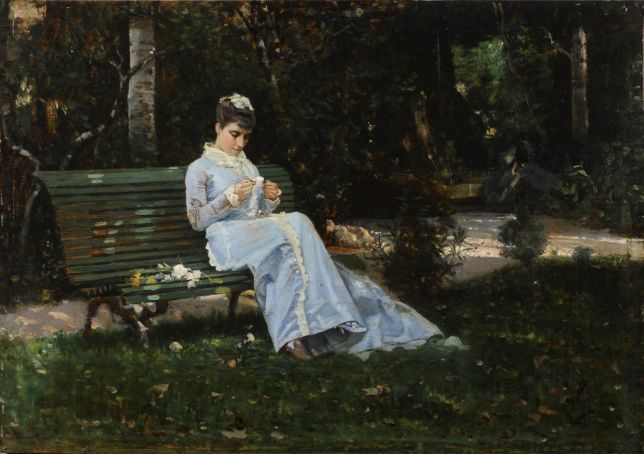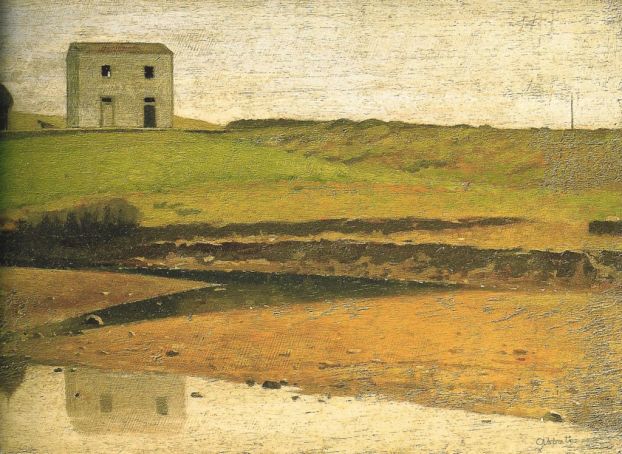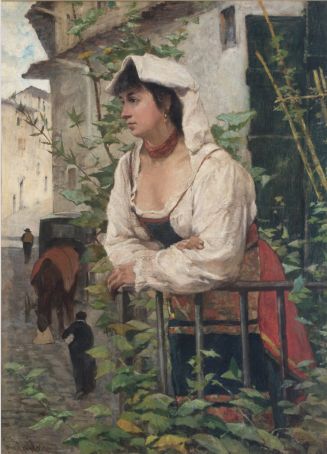Review of I Macchiaioli: Le collezione svelate
16 March-4 Sept. This is the second time in recent years that the Chiostro del Bramante has dedicated an exhibition to the Macchiaioli, a group of idealistic Italian painters active in the second half of the 19th century. However, unlike the 2007 show which charted the history of the Tuscan movement, this exhibition is as much a tale of the Macchiaioli as their patrons who allowed the artists to develop their groundbreaking work.
Speaking at the exhibition preview on 15 March, curator Francesca Dini underlined the enormous debt owed to these private individuals who not only assembled fine collections but nurtured the Macchiaioli's progression. Dini, who also curated the 2007 show, said the new exhibition “lives up to its name” by unveiling paintings that have never been seen in public. Drawing from nine important collections, the exhibition comprises over 110 works and is divided into nine sections, each named after a collector who helped to shape the Macchiaioli movement.
In a similar way to the better-known Parisian Impressionists, who came a decade later, the Macchiaioli spurned the outdated conventions of art academies, working en plein air to capture natural light, shade and colour, as well as painting portraits. Their name is a play on the Italian word macchie, meaning "spots" or "stains", used to describe the patches of sunlight and shadow which were central to their work. The other meaning of macchie – “scrubland” – was used by art critics of the day to mock the Macchiaioli, belittling their work as unfinished sketches painted in the wild, not polished academic paintings completed in the studio.
Despite being effectively outcast by the establishment, the Macchiaioli captured the imagination of a handful of collectors who saw in their paintings an authenticity, enthusiasm and independence, a romantic and windswept quest for beauty and modernism. The Chiostro del Bramante pays tribute to these collectors, acknowledging the vital lifeline that they provided to the movement a century and a half ago.
The exhibition begins with paintings from the Cristiano Banti collection, including the Impressionistic Ritratto di Alaide Banti in giardino by Banti who, in addition to being a leading member of the Macchiaioli, assembled works by his counterparts who viewed his collection as a mirror into their collective progession.

A gem from the Diego Martelli collection, the core of which plays a significant role in the Gallery of Modern Art at Palazzo Pitti in Florence, is an understated drawing of trees on brown paper by Giuseppe Abbati, a major player in the movement. Nearby is a portait of Abbati by a young Giovanni Boldini, showing the artist without the eye he lost in the Battle of Capua, during Garibaldi's 1860 campaign. Within three years Abbati was dead from rabies, aged 32, after being bitten by his dog Cennino, who appears alongside him in Boldini's portrait.
Rinaldo Carnielo was a Florentine artist whose collection of more than 300 Macchiaioli works was dispersed in a series of sales in 1929. On display is the beautifully desolate Casa sul botro by his friend Giovanni Fattori, the best known of the Macchiaioli.

The largest works in the exhibition – several of them scenes of soldiers mustering cattle by Fattori – can be found in the room dedicated to Turin merchant Edoardo Bruno whose 400-strong collection became a place of pilgrimage for Macchiaioli scholars in the 1920s. A centrepiece is Cucitrici di camicie rosse by Odoardo Borrani, a solemn scene of well-dressed women sewing at a dining-room table with a portrait of Garibaldi in the background, while with Uliveta a Settignano by Telemaco Signorini one can almost feel the heat of the sun on the ochre earth, practically hear the crickets in the olive grove.

On the first floor, the Casa Sforni collection includes previously unseen works by Fattori and the striking Bambino con fiocco rosso by Oscar Ghiglia, as well as Paesaggio rosa con figura painted much later (1916) by Llewelyn Lloyd. This Welsh-Italian trained as a painter in Livorno where he met many artists, among them Modigliani, before following the elder Fattori to Florence.

The collection of the “most acute and refined connoisseur of the Macchiaioli”, sculptor Mario Galli, includes an exquisite series of five small elongated landscapes by Borrani, looking over fields and allotments towards the mountains and sea. There is also Ciociara, a portait of the 19-year-old Hungarian governess Amalia Nollemberg with whom Fattori had a passionate but much frowned-upon affair.

Things take an even prettier turn with Il giubetto rosso by Italian Impressionist Federico Zandomeneghi in the Camillo Giussani collection, while the exhibition ends with the magnificent Ponte Vecchio a Firenze by Telemaco Signorini. The work, a lively scene featuring all strands of society crossing the mediaeval bridge, belongs to a section dedicated to the 20th-century collector Mario Borgiotti whose studies have helped to give the Macchiaioli artists the recognition they deserve but have yet to fully attain.
Andy Devane
General Info
View on Map
Review of I Macchiaioli: Le collezione svelate
Chiostro del Bramante, Via Arco della Pace 5, tel. 06916508451.

















